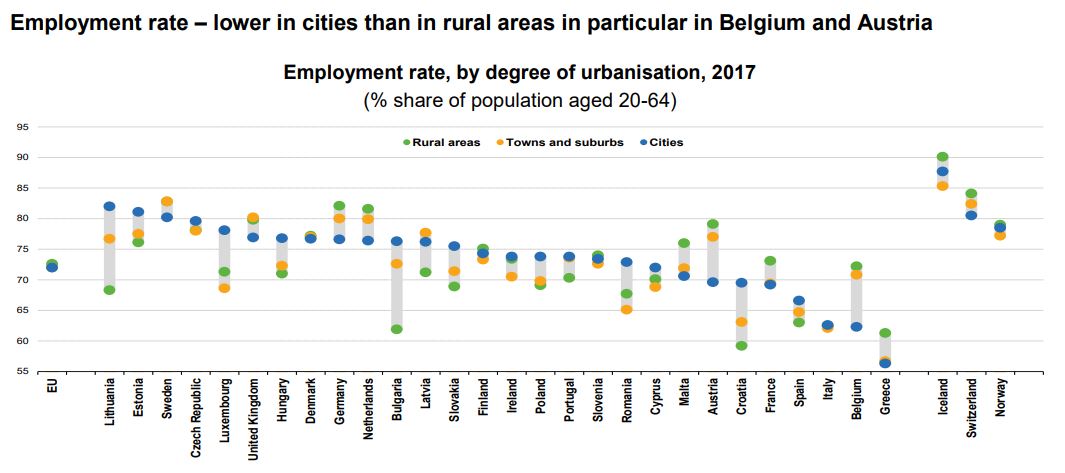Is life expectancy in your region higher than in other regions of the European Union (EU)? What is the quality of life in your region? How much entrepreneurial activity takes place is your region? How much money is invested in research and innovation? Is your region richer than others? Which region has the highest internet use and do those internet users participate in social networks?
You can find answers to these and many more questions in the 2018 edition of Eurostat regional yearbook, published each year by Eurostat, the statistical office of the European Union. It contains chapters on regional policies and European Commission priorities, as well as statistics on population, health, education and training, labour market, economy, structural business statistics, research and innovation, digital economy and society, tourism, transport and agriculture. It also includes two special statistical focus chapters: the first is on cities and the second on regional typologies. This News release focuses on differences in employment rates in cities and rural areas, life expectancy between men and women and social media usage at regional level.
The regional yearbook provides an overview of the wide range of regional statistics available for the 276 regions at NUTS level 2 (Nomenclature of territorial units for statistics) and, for some indicators, the 1 342 smaller regions at NUTS level 3. Data is available for all 28 Member States of the EU and, where possible, regions in the EFTA and candidate countries.

At EU level, little difference exists between the employment rates in rural areas (73%), and the rates in towns and suburbs, or in cities (both 72%). However, in the eastern part of the EU and the Baltic Member States, working-age people living in cities were much more likely to be in employment than those living in rural areas in 2017. The largest gap (14 percentage points (pp)) of the employment rate for working-age people living in cities and those living in rural areas was observed in Lithuania (82% for cities and 68% for rural areas) and Bulgaria (76% for cities and 62% for rural areas), followed by Croatia where the difference was 11 pp (70% employment rate for cities and 59% for rural areas).
On the other hand, for Member States in the western part of the EU, there tends to be higher employment rates recorded for working-age people living in rural areas than in cities. The largest differences were observed in Belgium, where the employment rate for working-age persons living in rural areas was 72%, 10pp higher than for those living in cities (62%), followed by Austria with a difference of 9pp (70% for cities and 79% for rural areas), the Netherlands (76% and 82%) with 6pp of the difference, Germany (77% and 82%), Malta (71% and 76%) and Greece (56% and 61%) – all three with a difference of 5pp.
Life expectancy for women in the EU was on average 83.6 years, compared with 78.2 years for men.
Among the top 10 regions in the EU with the highest level of life expectancy for women, six regions were in Spain (with highest life expectancy in Comunidad de Madrid of 87.8 years), three in France (with highest life expectancy in Corse of 87.1 years) and one in Italy (Provincia Autonoma di Trento of 86.9 years).
On the other hand, when looking at the EU’s top 10 regions with the highest level of life expectancy for men, one region was in Spain (Comunidad de Madrid of 82.2 years), seven regions were in Italy (with highest life expectancy in Umbria of 81.8 years) and two in the United Kingdom (with highest life expectancy in Inner London – West of 82.1 years).
The largest gender gaps in life expectancy for NUTS 2 regions were recorded in the three Baltic Member States.
Women in Lithuania could expect to live almost 11 years longer than men, in Latvia the gap ran at 10 years, while in Estonia women could expect to live nine years more than men. There were no regions in the EU where the average life expectancy at birth was higher for men than for women.
The EU regions with the highest use of social media were principally located in Belgium, the Nordic Member States and the United Kingdom.
More than half (54%) of the population aged 16-74 years in the EU used the internet to participate in social networks (by using websites such as Instagram, Facebook or Twitter) in 2017.
In 2017, among the regions, the highest shares of population aged 16-74 years taking part in social media were observed in Mellersta Norrland in Sweden (85%), the Danish capital Hovedstaden (79%), Prov. WestVlaanderen in Belgium, the Swedish capital Stockholm and Wales in the United Kingdom (all 76%).
At the other end of the range, the lowest participation rates were found in the French regions of La Réunion (34%) and Limousin (35%), followed by Puglia in Italy (37%), Poitou-Charentes and Basse-Normandie in France as well as Brandenburg in Germany (all 38%).
Methods and definitions
Cities (densely populated areas): areas where at least half of the population lives in urban centres (with a population density of at least 1 500 inhabitants per km2 and a minimum of 50 000 inhabitants).
Towns and suburbs (intermediate density areas): areas where less than half of the population lives in rural grid cells and less than half of the population lives in urban centres.
Rural areas (thinly populated areas): areas where more than half of the population lives in rural grid cells (with a population density of less than 300 inhabitants per km2 and less than 5 000 inhabitants in total).
For more information
Eurostat regional yearbook 2018 edition.
Source: Eurostat